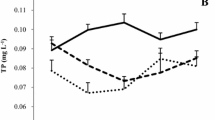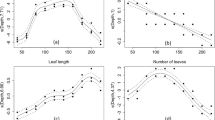Abstract
Due to climate change, water level fluctuations (WLFs) in shallow lakes are expected to increase in the future. Such fluctuations significantly affect the growth and reproduction of submerged macrophytes, but the role of WLF on plant physiological mechanisms is far from clear. Our aims are to examine the effects of WLF on the submerged macrophyte Vallisneria spinulosa by testing changes in (1) chloroplast pigments, (2) the response of antioxidant enzymes, (3) the concentrations of carbon (C), nitrogen (N) and phosphorus (P) and (4) plant stoichiometry (ratios of C/N, C/P and N/P). In outdoor mesocosms, plants were subjected to two amplitudes and two frequencies of WLF, with stable water level as a control. Generally, compared with the control, the fluctuation treatments showed higher chlorophyll a and b concentrations. Increased amplitude and frequency promoted peroxidase (POD) activity in V. spinulosa, indicating a response to oxidative stress, but superoxide dismutase (SOD) remained unchanged. Moreover, compared with the control, WLF generally increased leaf P and reversely affected the leaf C/P and N/P ratios of plants. The C and N contents in the plants were relatively stable following WLF, but with increasing WLF amplitude, P absorption (i.e. leaf P content) by V. spinulosa was promoted. Our results indicate that the ability of V. spinulosa to successfully grow in floodplains may be related to the physiological adaptive strategies according to the alterations in WLF. Combined effects of several hydrological factors on shallow lake should be further studied in order to maintain the health and sustainability of shallow lake systems.



Similar content being viewed by others
Availability of data and materials
The raw data supporting the conclusions of this article will be made available by the authors without reservation.
References
Ågren GI (2008) Stoichiometry and nutrition of plant growth in natural communities. Annu Rev Ecol Evol S 39:153–170. https://doi.org/10.1146/annurev.ecolsys.39.110707.173515
Baastrup-Spohr L, Moller CL, Sand-Jensen K (2016) Water-level fluctuations affect sediment properties, carbon flux and growth of the isoetid Littorella uniflora in oligotrophic lakes. Freshw Biol 61:301–315. https://doi.org/10.1111/fwb.12704
Bailey-Serres J, Chang R (2005) Sensing and signaling in response to oxygen deprivation in plants and other organisms. Ann Bot 96:507–518. https://doi.org/10.1093/aob/mci206
Beklioglu M, Altinayar G, Tan CO (2006) Water level control over submerged macrophyte development in five shallow lakes of Mediterranean Turkey. Arch Hydrobiol 166:535–556. https://doi.org/10.1127/0003-9136/2006/0166-0535
Blokhina O, Virolainen E, Fagerstedt KV (2003) Antioxidants, oxidative damage and oxygen deprivation stress: a review. Ann Bot 91:179–194. https://doi.org/10.1093/aob/mcf118
Boamfa EI, Veres AH, Ram PC, Jackson MB, Reuss J, Harren FJM (2005) Kinetics of ethanol and acetaldehyde release suggest a role for acetaldehyde production in tolerance of rice seedlings to micro-aerobic conditions. Ann Bot 96:727–736. https://doi.org/10.1093/aob/mci224
Britto DT, Kronzucker HJ (2005) Nitrogen acquisition, PEP carboxylase, and cellular pH homeostasis: new views on old paradigms. Plant Cell Environ 28:1396–1409. https://doi.org/10.1111/j.1365-3040.2005.01372.x
Casanova MT, Brock MA (2000) How do depth, duration and frequency of flooding influence the establishment of wetland plant communities? Plant Ecol 147:237–250
Chapin FS (1980) The mineral nutrition of wild plants. Annu Rev Ecol Evol Syst 11:233–260. https://doi.org/10.1146/annurev.es.11.110180.001313
Coops H, Beklioglu M, Crisman TL (2003) The role of water-level fluctuations in shallow lake ecosystems—workshop conclusions. Hydrobiologia 506–509:23–27. https://doi.org/10.1023/B:HYDR.0000008595.14393.77
Cunha SR, Tognella-De-Rosa MMP, Costa CSB (2006) Salinity and flooding frequency as determinant of mangrove forest structure in Babitonga Bay, Santa Catarina state, southern Brazil. J Coastal Res 33:1175–1180
Elser JJ, Acharya K, Kyle M, Cotner J, Makino W, Markow T, Watts T, Hobbie S, Fagan W, Schade J, Hood J, Sterner RW (2003) Growth rate-stoichiometry couplings in diverse biota. Ecol Lett 6:936–943. https://doi.org/10.1046/j.1461-0248.2003.00518.x
Ersoy Z, Scharfenberger U, Baho DL, Bucak T, Feldmann T, Hejzlar J, Levi EE, Mahdy A, Nõges T, Papastergiadou E, Stefanidis K, Šorf M, Søndergaard M, Trigal C, Jeppesen E, Beklioğlu M (2020) Impact of nutrients and water level changes on submerged macrophytes along a temperature gradient: a pan-European mesocosm experiment. Glob Change Biol. https://doi.org/10.1111/gcb.15338
Geest GJV, Wolters H, Roozen FCJM, Coops H, Roijackers RMM, Buijse AD, Scheffer M (2005) Water-level fluctuations affect macrophyte richness in floodplain lakes. Hydrobiologia 539:239–248. https://doi.org/10.1007/s10750-004-4879-y
Gu J, Xu ZH, Jin H, Ning XY, He H, Yu JL, Jeppesen E, Li KY (2016) Response of Vallisneria natans to increasing nitrogen loading depends on sediment nutrient characteristics. Water 8:563. https://doi.org/10.3390/w8120563
Havens KE, Sharfstein B, Brady MA, East TL, Harwell MC, Maki RP, Rodusky AJ (2004) Recovery of submerged plants from high water stress in a large subtropical lake in Florida, USA. Aquat Bot 78:67–82. https://doi.org/10.1016/j.aquabot.2003.09.005
He L, Zhu TS, Wu Y, Li W, Zhang H, Zhang XL, Cao T, Ni LY, Hilt S (2019) Littoral slope, water depth and alternative response strategies to light attenuation shape the distribution of submerged macrophytes in a mesotrophic lake. Front Plant Sci 10:169. https://doi.org/10.3389/fpls.2019.00169
Hirabayashi Y, Mahendran R, Koirala S, Konoshima L, Yamazaki D, Watanabe S, Kim H, Kanae S (2013) Global flood risk under climate change. Nat Clim Change 3:816–821. https://doi.org/10.1038/nclimate1911
Hou JJ, Liu YF, Fraser JD, Li L, Zhao B, Lan ZC, Jin JF, Liu GH, Dai NH, Wang WJ (2020) Drivers of a habitat shift by critically endangered Siberian cranes: evidence from long-term data. Ecol Evol. https://doi.org/10.1002/ece3.6720
IPCC (2014) Intergovernmental panel on climate change 2014: impacts, adaptation, and vulnerability. Cambridge University Press, Cambridge
Iversen L, Winkel A, Baastrup-Spohr L et al (2019) Catchment properties and the photosynthetic trait composition of freshwater plant communities. Science 366:878–881. https://doi.org/10.1126/science.aay5945
Jeppesen E, Søndergaard M, Søndergaard M, Christoffersen K (1998) The structuring role of submerged macrophytes in lakes. Springer, New York. https://doi.org/10.1007/978-1-4612-0695-8
Jeppesen E, Brucet S, Naselli-Flores L et al (2015) Ecological impacts of global warming and water abstraction on lakes and reservoirs due to changes in water level and related changes in salinity. Hydrobiologia 750:201–227. https://doi.org/10.1007/s10750-014-2169-x
Ji Y, Yao ZD, Zhang J, Wang XR, Luo JX, Xiao LY, Zhang SF (2018) Integrated biomarker responses of the submerged macrophyte Vallisneria spiralis via hydrological processes from Lake Poyang, China. R Soc Open Sci 5:180729. https://doi.org/10.1098/rsos.180729
Kong XZ, He QS, Yang B et al (2017) Hydrological regulation drives regime shifts: evidence from paleolimnology and ecosystem modeling of a large shallow Chinese lake. Global Change Biol 23:737–754. https://doi.org/10.1111/gcb.13416
Li HS, Sun Q (2000) The experiment principle and technology of plant physiology. Higher Education Press, Beijing
Li W, Liu GH, Xiong BH, Pu YH (2004) The restoration of aquatic vegetation in lakes of Poyang Lake Nature Reserve after catastrophic flooding in 1998. Journal of Wuhan Botanical Research 22:301–306. https://doi.org/10.1088/1009-0630/6/5/011(in Chinese with English abstract)
Li W, Cao T, Ni LY, Zhang XL, Zhu GR, Xie P (2013) Effects of water depth on carbon, nitrogen and phosphorus stoichiometry of five submersed macrophytes in an in situ experiment. Ecol Eng 61:358–365. https://doi.org/10.1016/j.ecoleng.2013.09.028
Li L, Bonser SP, Lan ZC, Xu LG, Chen JK, Song ZP (2017) Water depth affects reproductive allocation and reproductive allometry in the submerged macrophyte Vallisneria natans. Sci Rep 7:16842. https://doi.org/10.1038/s41598-017-16719-1
Li L, Lan ZC, Chen JK, Song ZP (2018) Allocation to clonal and sexual reproduction and its plasticity in Vallisneria spinulosa along a water-depth gradient. Ecosphere 9:e02070. https://doi.org/10.1002/ecs2.2070
Li L, Barrett SCH, Song ZP, Chen JK (2019) Sex-specific plasticity of reproductive allocation in response to water depth in a clonal, dioecious macrophyte. Am J Bot 106:42–50. https://doi.org/10.1002/ajb2.1218
Li L, Ding MM, Jeppesen E (2020) Variation in growth, reproduction, and resource allocation in an aquatic plant, Vallisneria spinulosa: the influence of amplitude and frequency of water level fluctuations. Aquat Sci 82:81. https://doi.org/10.1007/s00027-020-00754-8
Lu J, Bunn SE, Burford MA (2018) Nutrient release and uptake by littoral macrophytes during water level fluctuations. Sci Total Environ 622:29–40. https://doi.org/10.1016/j.scitotenv.2017.11.199
Luo FL, Thiele B, Janzik I, Zeng B, Schurr U, Matsubara S (2012) De-submergence responses of antioxidative defense systems in two wetland plants having escape and quiescence strategies. J Plant Physiol 169:1680–1689. https://doi.org/10.1016/j.jplph.2012.06.015
Malheiro ACE, Jahns P, Hussner A (2013) CO2 availability rather than light and temperature determines growth and phenotypical responses in submerged Myriophyllum aquaticum. Aquat Bot 110:31–37. https://doi.org/10.1016/j.aquabot.2013.05.001
Maxwell PS, Pitt KA, Burfeind DD, Olds AD, Babcock RC, Connolly RM (2014) Phenotypic plasticity promotes persistence following severe events: physiological and morphological responses of seagrass to flooding. J Ecol 102:54–64. https://doi.org/10.1111/1365-2745.12167
Nawaz T, Hameed M, Ashraf M, Ahmad MSA, Batool R, Fatima S (2014) Anatomical and physiological adaptations in aquatic ecotypes of Cyperus alopecuroides Rottb. under saline and waterlogged conditions. Aquat Bot 116:60–68. https://doi.org/10.1016/j.aquabot.2014.01.001
Pilon J, Santamaría L (2002) Clonal variation in morphological and physiological responses to irradiance and photoperiod for the aquatic angiosperm Potamogeton pectinatus. J Ecol 90:859–870. https://doi.org/10.1046/j.1365-2745.2002.00716.x
Rabe E (1990) Stress physiology: the functional significance of the accumulation of nitrogen-containing compounds. J Hortic Sci 65:231–243. https://doi.org/10.1080/00221589.1990.11516052
Rattray MR, Howard-Williams C, Brown JMA (1991) Sediment and water as sources of nitrogen and phosphorus for submerged rooted aquatic macrophytes. Aquat Bot 40:225–237. https://doi.org/10.1016/0304-3770(91)90060-I
Riis T, Hawes I (2002) Relationships between water level fluctuations and vegetation diversity in shallow water of New Zealand lakes. Aquat Bot 74:133–148. https://doi.org/10.1016/S0304-3770(02)00074-8
Sasidharan R, Hartman S, Liu Z, Martopawiro S, Sajeev N, van Veen H, Yeung E, Voeseneka LACJ (2018) Signal dynamics and interactions during flooding stress. Plant Physiol 176:1106–1117. https://doi.org/10.1104/pp.17.01232
Shi RH (1994) Agricultural and chemical analysis for soil. Science Press, Beijing, pp 212–218
Stokes K, Ward K, Colloff M (2010) Alterations in flood frequency increase exotic and native species richness of understorey vegetation in a temperate floodplain eucalypt forest. Plant Ecol 211:219–233. https://doi.org/10.1007/s11258-010-9833-7
Sultan SE, Wilczek AM, Bell DL, Hand G (1998) Physiological response to complex environments in annual Polygonum species of contrasting ecological breadth. Oecologia 115:564–578. https://doi.org/10.1007/s004420050554
Voesenek LACJ, Bailey-Serres J (2015) Flood adaptive traits and processes: an overview. New Phytol 206:57–73. https://doi.org/10.1111/nph.13209
Wang MZ, Liu ZY, Luo FL, Lei GC, Li HL (2016) Do amplitudes of water level fluctuations affect the growth and community structure of submerged macrophytes? PLoS ONE 11:e0146528. https://doi.org/10.1371/journal.pone.0146528
Wei H, He F, Xu D, Zhou QH, Xiao ER, Zhang LP, Wu ZB (2018) A comparison of the growth and photosynthetic response of Vallisneria natans (Lour.) Hara to a long-term water depth gradient under flowing and static water. J Freshwater Ecol 33:223–237. https://doi.org/10.1080/02705060.2018.1432509
Wei GW, Chen Y, Sun XS, Chen YH, Luo FL, Yu FH (2019) Growth responses of eight wetland species to water level fluctuation with different ranges and frequencies. PLoS ONE 14:e0220231. https://doi.org/10.1371/journal.pone.0220231
Wiley E, Helliker B (2012) A re-evaluation of carbon storage in trees lends greater support for carbon limitation to growth. New Phytol 195:285–289. https://doi.org/10.1111/j.1469-8137.2012.04180.x
Yu LF, Yu D (2009) Responses of the threatened aquatic plant Ottelia alismoides to water level fluctuations. Fund Appl Limnol 174:295–300. https://doi.org/10.1127/1863-9135/2009/0174-0295
Yuan GX, Fu H, Zhong JY, Lou Q, Ni LY, Cao T (2016) Growth and C/N metabolism of three submersed macrophytes in response to water depths. Environ Exp Bot 122:94–99. https://doi.org/10.1016/j.envexpbot.2015.09.009
Zhang YS, Huang X, Chen YF (2009) Experimental course of plant physiology. Higher Education Press, Beijing, pp 139–140
Zhang XK, Liu XQ, Ding QZ (2013) Morphological responses to water-level fluctuations of two submerged macrophytes, Myriophyllum spicatum and Hydrilla verticillata. J Plant Ecol 6:64–70. https://doi.org/10.1093/jpe/rts009
Zhang YL, Jeppesen E, Liu XH, Qin BQ, Shi K, Zhou YQ, Thomaz SM, Deng JM (2017) Global loss of aquatic vegetation in lakes. Earth Sci Rev 173:259–265. https://doi.org/10.1016/j.earscirev.2017.08.013
Zhang XL, Ma DY, Pulzatto MM, Yu HW, Liu CH, Yu D (2020) Moderate hydrological disturbance and high nutrient substrate enhance the performance of Myriophyllum aquaticum. Hydrobiologia. https://doi.org/10.1007/s10750-020-04397-6
Zhi YW, Cao Y, Sun JY, Li W, Jeppesen E (2018) Indirect effects of extreme precipitation on the growth of Vallisneria denseserrulata Makino. Environ Exp Bot 153:229–235. https://doi.org/10.1016/j.envexpbot.2018.06.003
Zhou Y, Li L, Song ZP (2019a) Plasticity in sexual dimorphism enhances adaptation of dioecious Vallisneria natans plants to water depth change. Front Plant Sci 10:826. https://doi.org/10.3389/fpls.2019.00826
Zhou YQ, Ma JR, Zhang YL, Li JB, Feng L, Zhang YB, Shi K, Brookes JD, Jeppesen E (2019b) Influence of the three Gorges Reservoir on the shrinkage of China’s two largest freshwater lakes. Global Planet Chang 177:45–55. https://doi.org/10.1016/j.gloplacha.2019.03.014
Zhu GR, Li W, Zhang M, Ni LY, Wang SR (2012) Adaptation of submerged macrophytes to both water depth and flood intensity as revealed by their mechanical resistance. Hydrobiologia 696:77–93. https://doi.org/10.1007/s10750-012-1185-y
Acknowledgements
We would like to thank Yu Zhang, Xiuzhi Wang, Zhuoyi Lin, Fan Wu and Yasong Chen for field and laboratory assistance and Anne Mette Poulsen for language assistance. Moreover, we would like to thank the Poyang Lake Laboratory for Wetland Ecosystem Research, Chinese Academy of Sciences, for letting us use its outdoor experimental mesocosm facility. This work was funded by the National Key R&D Program of China (2018YFD0900904), the National Natural Science Foundation of China (31960248, 31400403) and the Natural Science Foundation of Jiangxi Province (20192BAB204006, 20161BAB214157). EJ was supported by the TÜBITAK Outstanding Researcher Program BIDEB2232 (Project 118C250).
Author information
Authors and Affiliations
Contributions
LL contributed to conceptualization, methodology, formal analysis, data curation, writing—original draft preparation, writing—reviewing and editing and funding acquisition; DM, ZR and CT were involved in investigation; HL contributed to writing—reviewing; and EJ was involved in writing—reviewing and editing.
Corresponding author
Ethics declarations
Conflict of interest
The authors declare that they have no known competing financial interests or personal relationships that could have influenced the work reported in this paper.
Additional information
Publisher's Note
Springer Nature remains neutral with regard to jurisdictional claims in published maps and institutional affiliations.
Handling Editor: Télesphore Sime-Ngando.
Rights and permissions
About this article
Cite this article
Ding, M., Zhou, R., Chen, T. et al. Physiological adaptations of the submerged macrophyte Vallisneria spinulosa in response to water level fluctuations. Aquat Ecol 55, 33–45 (2021). https://doi.org/10.1007/s10452-020-09808-3
Received:
Accepted:
Published:
Issue Date:
DOI: https://doi.org/10.1007/s10452-020-09808-3




